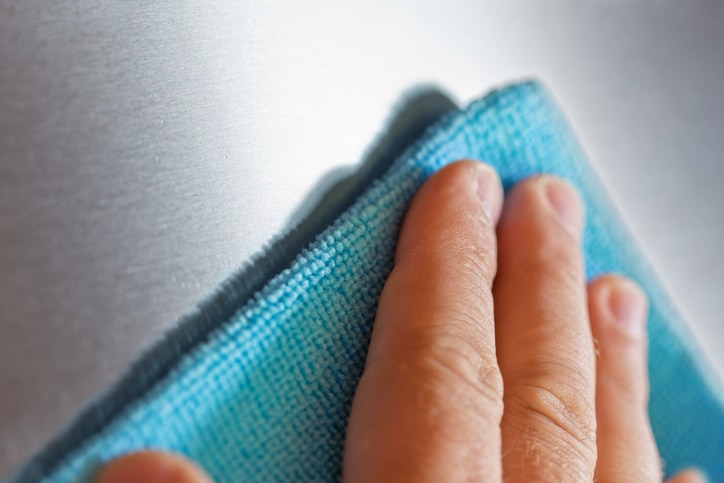Not sure how to remove built-up food residue from pots and pans? Or how to clean your dark and cloudy toaster oven window? It’s easier if you know how! And you don’t need a thousand pricey cleaning products to get the job done.
Leslie Reichert, a green home-keeping expert and the author of “The Joy of Green Cleaning,” says natural products can clean just about everything in the home. “Between baking soda and vinegar, I can clean most anything!” she asserts.
Below are 18 easy and fast cleaning hacks from Reichert and other cleaning experts. It’s so simple to learn how to clean nearly everything in your kitchen — and beyond:
1. Inside the microwave

“Steam lemon juice or white vinegar. Let the steam sit. Then wipe everything off,” Reichert suggests. “The acid in the steam removes built-up food.” But even heating plain water works, too.
2. Greasy baking sheets

Jill Nystul, a journalist-turned-blogger at One Good Thing by Jillee, uses baking soda and hydrogen peroxide to clean baking sheets, stove burner pans and her flat iron. She sprinkles on baking soda, pours on a little peroxide, sprinkles on more baking soda and waits at least two hours. After that, she says, you can practically just wipe it clean.
3. The oven

“One of my least favorite cleaning tasks in the kitchen used to be the inside of the oven,” says Nystul. “Scrubbing stubborn, greasy messes is hard enough without having to climb inside your oven to do it.” She puts a shallow dish with a cup of ammonia on the top rack, and a pot of boiling water on the lower. Let it sit overnight. In the morning, the mess wipes clean.
4. Toaster oven window

Got melted plastic or other buildup on your toaster oven window? Use a straight-edge razor at a 45-degree angle to remove it.
5. Waffle iron

A knife wrapped in a napkin gets inside ridges without scratching the surface.
6. Coffee maker

Run water mixed with white vinegar through the system. Then run plain water through twice more. Carefully scrub inside the pot with ice cubes and salt.
7. Humidifier

Run white vinegar through the system. Once you smell vinegar in the air, turn it off and let it sit overnight so the acid kills the bacteria. In the morning, run plain water through the system until the vinegar smell is gone.
8. Fingerprints on stainless steel

“The reason stainless steel appliances get fingerprints is that they are oxidizing,” says Reichert. Scrub the area with a gentle scrubbing powder or baking soda, then rinse. “To keep it clean, use a microfiber cloth.”
9. Kitchen walls
Reichert wipes food grease off walls with a rag dabbed with rubbing alcohol to cut grease and oil. Since it’s flammable, make sure there are no open flames when you clean. “If it’s been there a while, you can mix alcohol with baking soda,” says Reichert. “The alcohol cuts grease — the baking soda scrubs the stuck-on spots.”
10. Tile grout

Using an old toothbrush, scrub grout with a paste of hydrogen peroxide and borax.
11. Stained countertops
Scrub stains off counters with a whitening toothpaste.
12. Rug stains

Dab a little club soda on the stain. If that doesn’t work, spray hydrogen peroxide mixed with water to lift stains. Then absorb with a clean towel.
13. Kitchen trash can
Take it outside and spray it with a hose, preferably before it starts to smell. Then let it dry outside. Use a baking soda paste on caked-on grime before spraying.
14. Stained pan bottoms

Use a mixture of salt, borax and baking soda with a Mr. Clean Magic Eraser sponge.
15. Cast-iron skillet
Don’t use soap! Soak the pan in water. Then scrub with a chainmail scrubber. Scrubbing tough spots with a plastic scrubber works, too.
16. Range hood

Lots of kitchen surfaces get coated with residue that’s hard to clean. Nystul swears by fighting oil with oil. She pours a few drops of mineral oil on a microfiber cloth or paper towel and wipes the oily gunk right off.
17. Mirrors and windows
For streak-free cleaning, use a fine woven microfiber cloth, such as an eyeglass cloth.
18. Any surface
Mr. Clean Magic Eraser sponges clean fiberglass, stainless appliances, countertops, tables, walls — even the kitchen sink — without stripping the surface or leaving residue.
Wondering how to clean other tricky items? A little science goes a long way. “The trick is knowing what you’re cleaning, then figuring out what you have to clean it with,” says Reichert. For instance, alcohol breaks down oil, and lemon juice bleaches out stains. “It’s simple once you realize it’s just science,” she notes.





